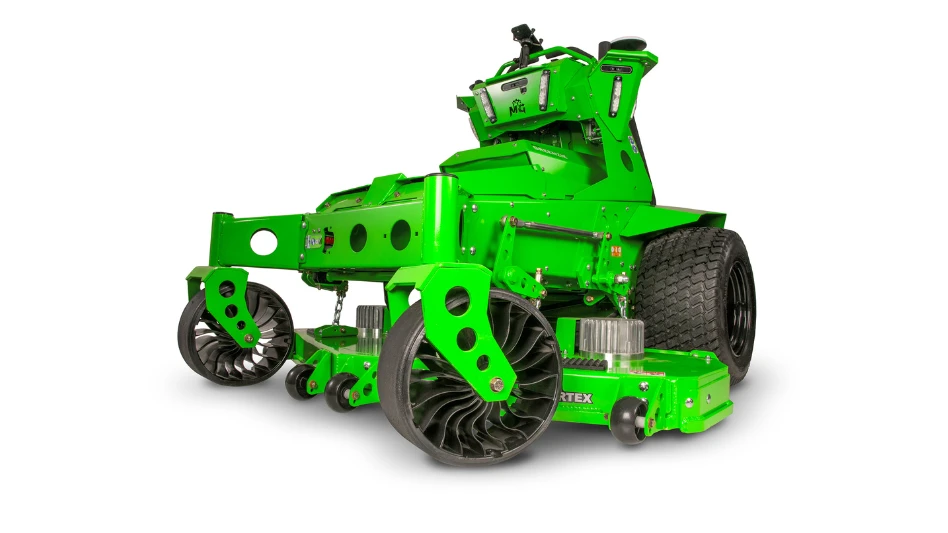Bowie Retzlaff is pumped up for this coming busy season. His start-up landscape installation business has taken off over the last few years thanks to concrete curbing, a business offering he discovered on the Web a few months before launching his company in 2004.
Although Retzlaff had never heard of the service before, he was confident he could master the hands-on side of the business, considering his background in landscaping, remodeling and masonry, which he learned growing up while working for his uncle, a mason.
A quick flip through the local Yellow Pages convinced Retzlaff curbing would be a good offering.
The phone book listed zero companies as concrete curbing providers, but it did advertise more than 50 landscape businesses. What a great differentiator this concrete curbing would be for his new business, he thought.
Curb ‘n Décor, Retzlaff’s Green Bay, Wis.-based landscape installation business, was incorporated in December of 2004. He was installing concrete curbing by springtime.
This year, just his third season in business, Retzlaff hopes to double his concrete curbing sales to more than $150,000.
In 2006 curbing made up 70 percent of his firm’s revenue. “If I can make it 90 percent curbing I will,” Retzlaff says. “You’re in, you’re out, the profits are excellent and when the homeowners come outside and see what you’ve done, the look on their face is amazing.”
Concrete edging brings a decorative element to the practical purpose for landscape edging: keeping mulch in place and adding an overall tidiness to beds.
It offers an artistic touch that plastic, metal and natural edging don’t. Another benefit is longevity – concrete is a permanent solution compared to plastic and metal edging that needs to be replaced in as few as three years, bricks that can shift and crumble and timber, which can rot.
Decorative curbing, though sometimes requested by commercial clients, is typically a residential offering, Retzlaff says, noting 90 percent of his curbing clients are homeowners. Curbing appeals to a wide variety of residential customers, from those in modest middle-class ranch homes to high-end homes in brand-new neighborhoods, Retzlaff says.
An average job is about 200 to 250 feet of curbing – though he’s done smaller ones and has bid on jobs up to 1,000 feet. A job in the 200-foot range would earn Retzlaff about $1,500 with a profit margin close to 60 percent.
That’s much higher than the 25 to 30 percent profit he gets from his company’s other landscape services.
SYSTEM DETAILS. The concrete curbing process entails removing sod from application areas (typically around bed edges), laying down the concrete, adding color, texture and stamping the pattern on top. Finally, the contractor applies a sealer.
There are several different types of concrete curbing systems on the market that vary in application method and curb size and style.
For example, some systems lay down 6-inch curbs; others produce 7-inch curbs. Some require a three-step process: one pass for laying down concrete, a second for adding color and third for stamping.
Other systems eliminate the color application step because color is mixed directly into the concrete. There are benefits to each type, says Retzlaff who owns two different concrete curbing systems. He first bought a machine that produces 7-inch curbs, which requires the three-step process in addition to adding a return trip several days later to apply sealer. This machine allows a three-man crew to install about 300 feet of curbing per day.
When adding a second machine to his operation, Retzlaff decided to go with a different type of machine that allows him to install 600 feet of curbing per day with a three-man crew. Additionally, this brand does not require an additional pass for color application or a second trip for sealer application.
“The whole process is a lot faster,” he says. “With the same crew, I’m able to do 600 feet a day without having to return. I can throw a sealer on top of it once it sets up and walk away and not have to come back.”
However, he still runs the first machine he bought. Keeping both systems allows Retzlaff to offer clients two sizes, 30 different colors and 30 different patterns.
BUYING DECISIONS. For contractors interested in entering the decorative curbing business, manufacturers offer a variety of equipment-purchasing options, too. Contractors’ options range from purchasing the machine and cement mixer only, to entire franchises or turn-key packages.
When Retzlaff first entered the concrete curbing business in early 2005 he declined to purchase a $45,000 package the manufacturer offered, which included a trailer, wheel barrows, other tools, training, marketing and support. Instead, he purchased just the curbing application equipment and sourced other materials separately. His initial investment was about $10,000 and came with one day of hands-on operations training, but no marketing or business training. Retzlaff says a contractor can enter the curbing business today for between $15,000 and $20,000.
PRICING POINTERS. Curb ‘n Décor’s concrete curbing prices range from $3.50 to $7 per linear foot. Customers have a lot of choices in curb style, which accounts for the variation in price, Retzlaff says. For example, $3.50 would buy 1 foot of an institutional-looking colorless, patternless curb.
Upgrade options include colors, stamped patterns and textures. “I personally add 50 cents for each separate service per foot,” Retzlaff says. The size of the curb (7-inch vs. 6-inch) also adds to the cost.
What’s the most popular decorative selection? “All three: color, stamping and texture,” Retzlaff says. “Customers figure as long as we’re here they might as well go for the gusto. You can lay down a light-colored gray curb and then a medium gray texture on top of that, and then a darker grey stamp pattern and you’ve got a multicolored curb that goes really well with stone or siding.”
Keeping the concrete curbs covered with a sealer is essential to their longevity, and Retzlaff plans to turn this light maintenance into an add-on service as his customers’ curbs age.
He applies a concrete sealer with each installation, and says sealer should be reapplied every three to five years (depending on the type of concrete and sealer used) to preserve the look and integrity of the concrete. “I give the customer the information that if it starts to dull they can go to Home Depot and buy a concrete sealer,” he says. “Otherwise I offer a service where I can come back for a set rate and take care of everything for them.” Since his curbing business is less than three years old, Retzlaff has only done this a few times upon special request. The process entails pressuring washing the curb and applying sealer. He charges $100 per visit plus 25 cents per foot.
MARKETING METHODS. So far, Retzlaff has marketed his business mostly through home and garden shows and the Yellow Pages. “I know other entrepreneurs and business owners and they recommended home shows,” he says. “By meeting the customer face to face, I think it gives them a sense of security knowing who you are, rather than just calling a number out of the phone book and having somebody show up at your house. It also helps because they get to physically see the product first.”
Retzlaff, whose marketing budget is between $7,000 and $8,000, exhibits at about three shows each season. Depending on the show, a 10-foot by 10-foot booth costs him $230 to $850, and this year he bought larger spaces to differentiate himself from his competitors and better showcase his landscape work. “I can use the bigger booth to show off my retaining walls and paver patios and surround the whole thing with curbing, shrubs and mulch,” he says. “The 20-foot booth catches a lot more people’s attention.”
Home shows were Retzlaff’s only marketing effort his first year in business and the leads he received there kept him busy all summer. “I try to hand out cards and information and go that route,” he says, noting he’s not a high-pressure salesman. He displays a voluntary sign-up sheet so he can follow-up with prospects who have expressed their interest as winter ends.
When he receives a call from a prospect, Retzlaff visits the site to measure bed areas with a measuring wheel. “We just walk around and discuss colors as I’m measuring,” he says.
In addition to keeping a portfolio of past jobs and letters of recommendation, Retzlaff keeps a few 1-foot samples of decorative curb in this truck so prospects can see and touch the real thing. If clients are still unsure, Retzlaff directs them to several installations he’s done before. “I have some customers who offer to have people come by and take a look at their homes,” he says. “I keep those addresses on me when I’m visiting customers, and I usually just ask the customer not to bother the homeowner, but to go check it out.
“A lot of my customers have existing landscapes,” Retzlaff adds. “It’s taken 15 years to grow everything to full size and they just want to put the final touches on it and curbing is perfect way to do it.”

Explore the May 2007 Issue
Check out more from this issue and find your next story to read.
Latest from Lawn & Landscape
- Connect, Control & Conserve with Horizon Technical Services
- Use Horizon's Parts Hotline
- How I built a Top 100 company
- Horizon’s Exclusive TurfGro Fertilizer
- Grow your business with mosquito control
- LandCare adds 2 branches in SoCal, promotes Aleman to branch manager
- Spray them away
- PERC helps debut propane direct-injection fuel system at ACT Expo 2025





